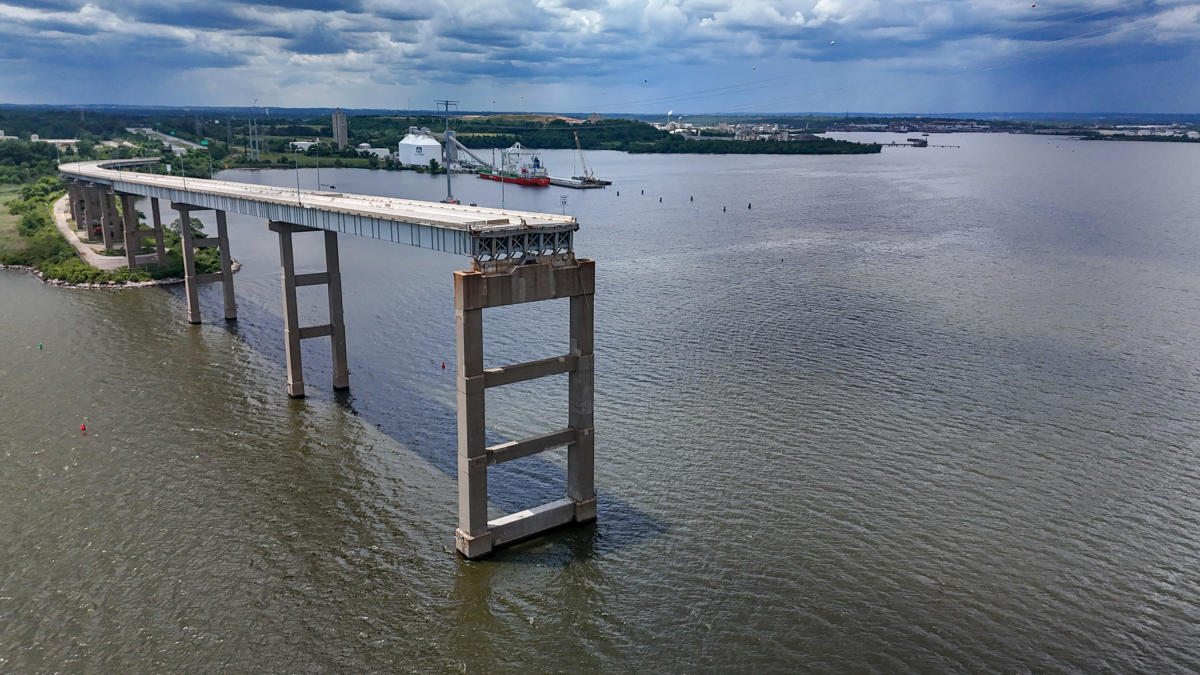
BALTIMORE — Each weekday, Baltimore-area motorists lose more than 20,000 vehicle-hours due to effects of traffic caused by the Francis Scott Key Bridge collapse, and each day, the state gets infinitesimally, but incrementally, closer to rebuilding the felled structure.
The Maryland Transportation Authority — the bridge’s owner — has applied for a Water Quality Certification and a Tidal Wetlands License, which are among the approvals it needs from the Maryland Department of the Environment. Simultaneously, the authority is preparing to demolish the structures that remain in the Patapsco River, as well as begin the process of designing the span alongside Kiewit, the private builder selected by the authority in late August. (Companies vying to rebuild the bridge were not asked to submit a finalized design as part of their application.)
The authority and Kiewit recently had a “formal kickoff meeting,” said the authority’s chief engineer, James Harkness, and have split into task forces as the design process begins in earnest. Although rough dimensions of the span are known and although many experts have predicted the bridge will be cable-stayed, it will be a while before the design, including visuals of what the span might look like, is finalized.
“The MDTA and the Design Build Team will be working on design for the next 12 months,” an authority spokesperson said in a statement Tuesday.
But some preliminary construction could begin before the design is finalized, and demolition certainly will take place before then. The ramps-to-nowhere that still sit in the Patapsco River, providing nothing but a memory of the span that was knocked down by a cargo ship March 26, killing six construction workers, will soon be destroyed and blasted to make way for the new span, as will the “dolphins” — the four concrete islands built to, ideally, protect the span from an errant vessel.
“We’re still working through a schedule for that,” Harkness told The Baltimore Sun on Tuesday, “but we’re looking for that late this year (or) early next year for demolition.”
Last week, the state’s Board of Public Works approved an environmental license to “remove bridge structure remnants” from the river “by blasting remaining in-water piers and dolphins, and removing existing dolphins, piers, and associated structures via barge with both clamshell bucket and excavators.”
Next up, the transportation authority will need similar approvals from the Maryland Department of the Environment and the Board of Public Works for rebuilding efforts, submitting more than 400 pages of application materials.
During a hearing Tuesday evening at the Dundalk campus of the Community College of Baltimore County, members of the public were invited to comment on the environmental approvals that the transportation authority is seeking. Matthew Garbark was dispatched from Baltimore Mayor Brandon Scott’s office to show “strong support of this rebuild.”
He cautioned that “immediately adjacent” to the bridge site is a 60-inch water main, maintained by the city of Baltimore, as well as a pipeline, operated by Baltimore Gas and Electric Co. (That pipeline was purged shortly after the collapse, but has since been reinstated.)
“I just ask that those be accounted for during this project so that there is no disturbance, or that disturbance is minimal,” said Garbark, the director of the Mayor’s Office of Infrastructure Development.
Bart Kennedy spoke on behalf of Sen. Chris Van Hollen, a Democrat, emphasizing that Maryland’s legislative delegation continues to “fight for 100%” federal funding of the rebuild. As is, the state of Maryland could be on the hook for a portion of the bridge cost, but if mandated by Congress, the federal government could pick up the entire tab, as promised by Democratic President Joe Biden in the immediate aftermath.
Otherwise, only three members of the public shared thoughts Tuesday, voicing support for the project, concern about ongoing traffic impacts and, in one case, sharing ideas for potential safety features — illustrated through a fictional, first-person narrative of an individual driving over the new bridge in 2028, when it is expected to be completed.
Meanwhile, ongoing traffic congestion underscores the project’s urgency.
Comparing April 2024 with April 2023 shows that Interstate 95 drivers experienced “more than 30 minutes of additional delay” during morning rush hour and then 20 minutes more in the evening, the transportation authority wrote in the “purpose and need” section of its application.
That, plus delays on I-895 totaled “approximately 21,000 collective hours of additional delay each day of the work week.”
_____
EMEA Tribune is not involved in this news article, it is taken from our partners and or from the News Agencies. Copyright and Credit go to the News Agencies, email news@emeatribune.com Follow our WhatsApp verified Channel



